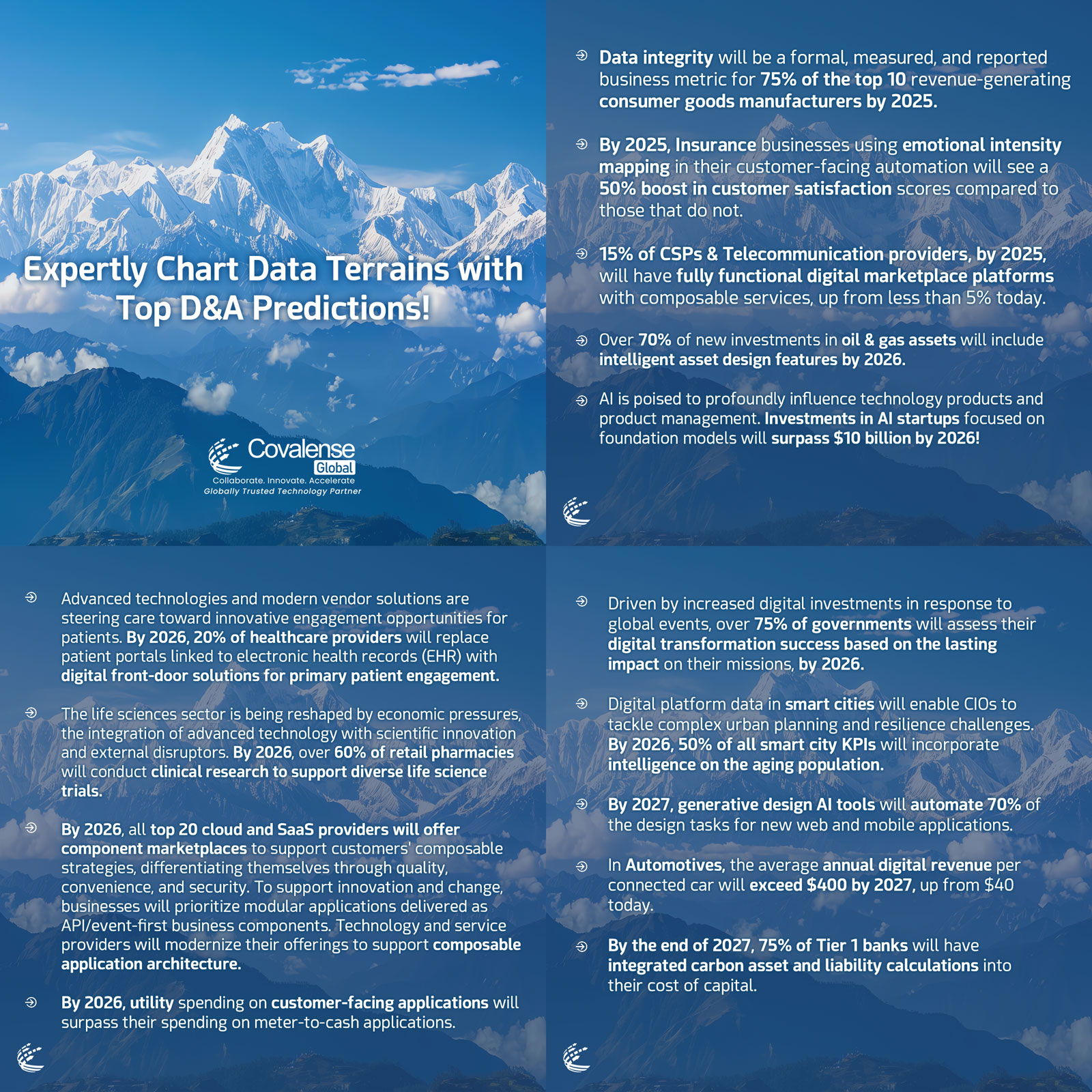
Accelerating Business Growth with Data & Analytics: The New Frontier of Success

Companies are increasingly recognizing that data is not just a byproduct of operations but a critical asset that can unlock new opportunities, optimize processes, and enhance customer experiences. As we move towards a data-driven future shaped, D&A is leading the charge, offering insights that enable informed decision-making and driving innovation across industries.
The Power of Data & Analytics in Modern Business
The value of Data & Analytics lies in its ability to turn raw data into actionable insights. These insights enable businesses to predict trends, understand customer behavior, streamline operations, and innovate faster than ever before. As customer expectations continue to evolve, companies must leverage D&A to deliver personalized experiences and remain agile in an increasingly competitive market.
In this environment, D&A is more than just a tool—it’s a strategic imperative. By integrating data into every facet of business operations, companies can enhance their decision-making processes, leading to more accurate predictions, better resource allocation, and ultimately, higher profitability. The benefits are clear: businesses that effectively utilize D&A are better positioned to capitalize on new opportunities, mitigate risks, and drive long-term growth.
Emerging D&A Trends Shaping Industries
As D&A continues to evolve, several emerging trends are set to reshape industries by 2028.
- Data Integrity as a Business Metric
By 2025, data integrity will be a formal, measured, and reported business metric for 75% of the top 10 revenue-generating consumer goods manufacturers. As the volume and complexity of data continue to grow, ensuring its accuracy, consistency, and reliability will become increasingly critical. Companies that prioritize data integrity will be better equipped to make informed decisions, maintain customer trust, and achieve regulatory compliance.
- AI and Emotional Intelligence in Insurance
The insurance industry is poised for transformation, with businesses using emotional intensity mapping in their customer-facing automation expected to see a 50% boost in customer satisfaction scores by 2025. By integrating AI with emotional intelligence, insurers can better understand and respond to customer needs, enhancing the overall customer experience and building stronger, more personalized relationships.
- Digital Marketplaces in Telecommunications
The telecommunications industry is also undergoing significant change, with 15% of Communications Service Providers (CSPs) and telecommunication providers expected to have fully functional digital marketplace platforms with composable services by 2025. These platforms will enable providers to offer more flexible and customizable solutions, driving innovation and improving customer satisfaction.
- Intelligent Asset Design in Oil & Gas
In the oil and gas sector, over 70% of new investments in assets will include intelligent asset design features by 2026. These advanced technologies will enable companies to optimize their operations, reduce costs, and improve safety, all while minimizing their environmental impact. As the industry continues to navigate challenges such as fluctuating demand and regulatory pressures, intelligent asset design will be key to maintaining profitability and sustainability.
- AI’s Influence on Technology Products
AI is set to profoundly influence technology products and product management, with investments in AI startups focused on foundation models expected to surpass $10 billion by 2026. These investments will drive the development of innovative AI solutions that can automate complex tasks, enhance decision-making, and create new business opportunities.
- Digital Transformation in Healthcare
The healthcare industry is embracing digital transformation, with advanced technologies and modern vendor solutions steering care toward innovative engagement opportunities for patients. By 2026, 20% of healthcare providers are expected to replace patient portals linked to electronic health records (EHR) with digital front-door solutions for primary patient engagement. These solutions will improve patient access to care, streamline communication, and enhance the overall patient experience.
- Life Sciences and Clinical Research
Economic pressures, technological advancements, and external disruptors are reshaping the life sciences sector. By 2026, over 60% of retail pharmacies will conduct clinical research to support diverse life science trials. This shift will enable pharmacies to play a more active role in the development of new treatments, driving innovation and improving patient outcomes.
- Composable Strategies in Cloud and SaaS
By 2026, all top 20 cloud and SaaS providers will offer component marketplaces to support customers’ composable strategies, differentiating themselves through quality, convenience, and security. These marketplaces will allow businesses to build modular applications tailored to their specific needs, enabling faster innovation and more agile responses to market changes.
- Customer-Facing Applications in Utilities
Utility companies are increasingly focusing on customer engagement, with spending on customer-facing applications expected to surpass spending on meter-to-cash applications by 2026. This shift reflects the growing importance of customer experience in the utility sector, as companies seek to improve service delivery and build stronger customer relationships.
- Digital Transformation in Government
Governments worldwide are investing heavily in digital transformation, driven by the need to respond to global events and improve public services. By 2026, over 75% of governments will assess their digital transformation success based on the lasting impact on their missions. This focus on outcomes rather than just technology adoption will lead to more effective and sustainable digital initiatives.
- Smart Cities and Aging Populations
Smart cities are leveraging digital platform data to tackle complex urban planning and resilience challenges. By 2026, 50% of all smart city KPIs will incorporate intelligence on the aging population, reflecting the growing need to address the unique challenges posed by an aging demographic.
- Generative AI in Design
Generative design AI tools are set to revolutionize the design process, with 70% of design tasks for new web and mobile applications expected to be automated by 2027. This automation will accelerate the design process, reduce costs, and enable designers to focus on more creative and strategic aspects of their work.
- Digital Revenue in Automotive
The automotive industry is undergoing a digital transformation, with the average annual digital revenue per connected car expected to exceed $400 by 2027, up from $40 today. This growth reflects the increasing demand for connected services and the opportunities for automakers to generate new revenue streams through digital offerings.
- Carbon Calculations in Banking
Sustainability is becoming a key consideration for financial institutions, with 75% of Tier 1 banks expected to integrate carbon asset and liability calculations into their cost of capital by 2027. This integration will enable banks to better assess the environmental impact of their investments and support the transition to a low-carbon economy.
As we look towards the future, it’s clear that Data & Analytics will continue to play a pivotal role in shaping business success. From enhancing customer experiences to driving innovation, D&A provides the insights and tools needed to navigate an increasingly complex and competitive landscape. At Covalense Global, we are committed to helping businesses harness the power of D&A to achieve their strategic objectives and redefine success in the digital age.
Source: Gartner
Author: Sales Team
Date: 26 August 2024
